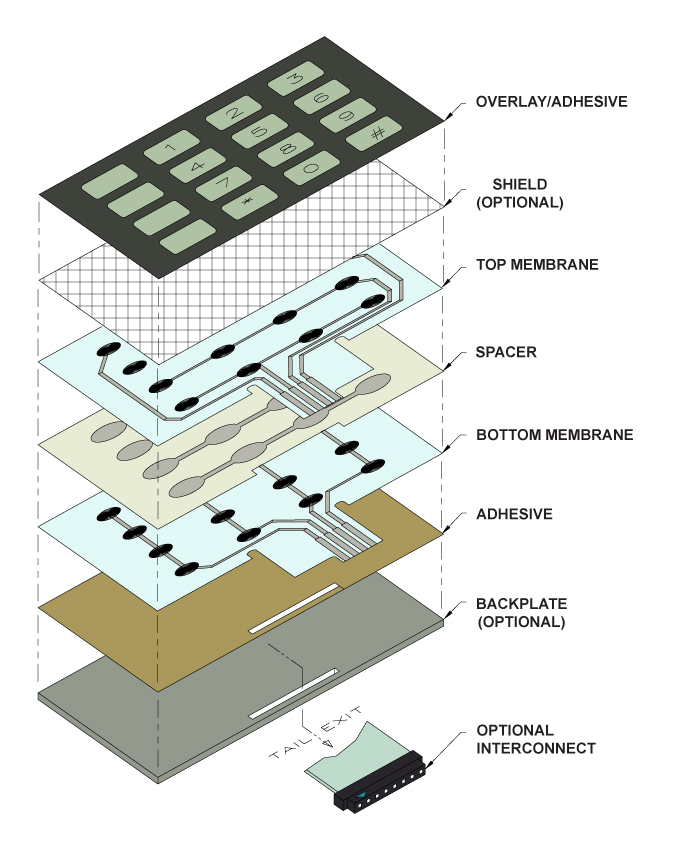Understanding the Performance of Membrane Switches Over for Individual User Interface Gadget
The performance of membrane switches over stands for a substantial advancement in interface style, integrating performance with aesthetic flexibility. These buttons operate via a multi-layered structure that converts user interactions into electrical signals, enabling both small designs and strength against ecological variables. As sectors progressively prioritize customer experience, comprehending the subtleties of membrane button modern technology ends up being crucial. What ramifications do these innovations hold for future applications, and just how might they redefine user interactions across different tools?
What Are Membrane Buttons?
Membrane layer switches are ingenious user interface gadgets that promote individual interaction with digital devices. These versatile parts contain numerous layers, including a graphic overlay, spacer, and a published circuit layer. The layout permits a seamless integration right into different digital gadgets, boosting both the aesthetic and useful facets of interface.
Membrane buttons are generally used in a vast array of applications, from family appliances to industrial equipment and clinical devices. Their building normally includes a slim profile, making them a perfect selection for portable styles. The responsive comments offered by these switches can be engineered to meet certain individual preferences, guaranteeing reliable interaction in between the customer and the device.
Durability is an additional considerable advantage of membrane layer buttons, as they are resistant to dirt, dampness, and chemicals, which boosts their life-span in demanding environments. In addition, these switches can be tailored in terms of form, dimension, and visuals design, enabling branding and user-specific features. Overall, membrane layer switches stand for a useful option for improving individual experience in electronic devices, incorporating functionality with visual allure in a reliable way.
Just How Membrane Changes Work
Operating on a straightforward principle, membrane switches make use of a layered building to sign up individual input successfully. Each button includes numerous layers, consisting of a published circuit layer, a spacer layer, and a top graphic layer, which are made to collaborate perfectly. When an individual presses the leading layer, it compresses the spacer layer, bringing the conductive aspects of the circuit layer right into call with each other.
This get in touch with develops a closed circuit, signaling the gadget to execute a certain function. The style enables different setups, including responsive responses, which can enhance the individual experience by offering a physical sensation upon activation. The products used in membrane switches frequently include versatile substrates, such as polyester or polycarbonate, which make sure sturdiness and resilience versus wear and tear.

Key Advantages of Membrane Buttons

Another significant advantage is their compactness. Membrane layer switches are thin and light-weight, which allows suppliers to conserve space in their gadgets without giving up functionality. This attribute is particularly valuable in applications where weight and volume are vital considerations.
In addition, membrane switches are resistant to dust, moisture, and chemicals, improving their toughness. This durability extends their life expectancy and minimizes the demand for constant replacements, resulting in expense savings gradually.
Additionally, the tactile feedback offered by membrane layer buttons can be optimized to improve individual interaction. They can consist of features such as elevated buttons or distinct clicks, enhancing usability and customer experience.
Applications Throughout Industries
Individual user interface tools utilizing membrane layer buttons are widespread in a vast variety of markets, showcasing their flexibility and functionality. Membrane Switch. In the medical field, membrane buttons are integral to tools such as analysis tools and patient tracking systems, this article where their longevity and convenience of cleansing are vital for maintaining hygiene standards. In the auto industry, these buttons are utilized in dashboard controls and infomercial systems, providing a smooth and modern-day user interface for individuals.
In addition, the consumer electronics industry advantages from membrane layer buttons in home appliances and handheld gadgets, where compact style and user-friendly user interfaces improve user experience. Industrial applications additionally leverage membrane layer switches over for control panels in machinery and automation systems, highlighting their robustness and resistance to harsh atmospheres.
In the aerospace and protection sectors, membrane switches are made use of in cockpit controls and equipment, where integrity and efficiency under severe conditions are paramount. In addition, the video gaming market increasingly integrates membrane layer buttons in controllers and gallery equipments, adding to an appealing individual experience. Overall, the adaptability of membrane switches allows their prevalent usage throughout many sectors, highlighting their importance in modern-day interface design.
Future Trends in Membrane Layer Change Technology

Furthermore, using sophisticated products, such as polycarbonate and polyester films, is expected to increase, supplying enhanced toughness and resistance to environmental stressors. These products add to the overall long life of membrane layer buttons, making them appropriate for harsher commercial applications.
In addition, the incorporation of smart modern technology, including IoT connection, will certainly make it possible for membrane layer switches to interact with various other gadgets and systems, promoting a more interactive customer experience. This fad straightens with the growing demand for wise tools throughout different markets, from medical care to consumer electronics.
Last but not least, modification alternatives are expected to expand, allowing producers to produce bespoke services customized to particular user needs and preferences. These advancements will certainly place membrane switches as necessary parts in the advancement of customer interface technology.
Final Thought
In verdict, membrane switches over represent an essential advancement in user interface innovation, offering a trustworthy and functional remedy for diverse electronic applications. As developments in material scientific research and touch sensing technologies proceed, the functionality and applicability of membrane layer buttons are anticipated to expand, enhancing their significance in modern electronic tools.
Comments on “Secret Advantages of Using a Membrane Switch in Industrial Applications”